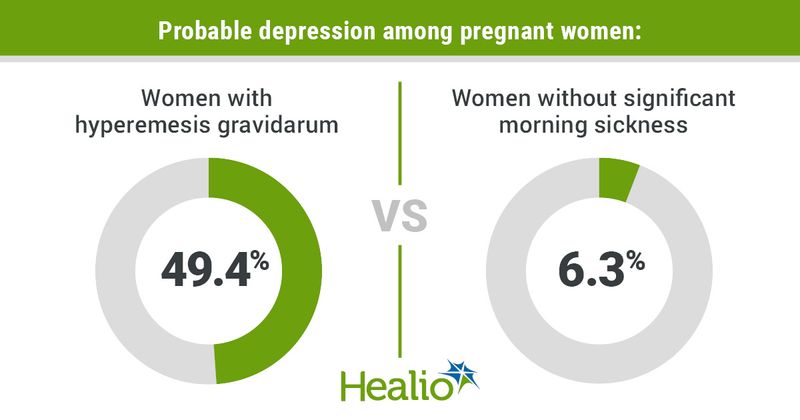Severe morning sickness linked to higher rates of antenatal, postnatal depression
Women with hyperemesis gravidarum, a severe form of morning sickness that occurs in 1% to 2% of pregnancies, may be more likely to experience depression during and after pregnancy, according to research published in BMJ Open.
“Our study shows that women with [hyperemesis gravidarum] are around eight times more likely to suffer antenatal depression and four times more likely to have postnatal depression,” Nicola Mitchell-Jones, MD, a senior registrar in obstetrics and gynecology at the National Health Service in the United Kingdom, said in a press release. “Some women in the study even had thoughts of self-harm whilst suffering [hyperemesis gravidarum].”

Mitchell-Jones and colleagues conducted a prospective, longitudinal, case-control, two-point survey study at multiple centers from April 2015 to April 2017 to compare the outcomes of pregnant women with hyperemesis gravidarum vs. a control group of pregnant women who did not have significant nausea and vomiting during pregnancy.
Pregnant women with hyperemesis gravidarum were recruited at hospital admission, and women who were at 12 weeks gestation or longer were recruited for the control group after presenting at a low-risk antenatal clinic. Women with mental health conditions at the time of enrollment were excluded from the study.
Participants were surveyed at 12 completed weeks gestation and again 6 weeks after delivery. The Edinburgh Postnatal Depression Scale was used in both surveys, and the postnatal survey included the Maternal-to-Infant Bonding Scale and a postnatal questionnaire on women’s psychological and psychosocial well-being during pregnancy.
The final analysis included 106 pregnant women with hyperemesis gravidarum and 108 pregnant women without the condition.
Researchers found that 49.4% of women with hyperemesis gravidarum had probable depression during pregnancy compared with just 6.3% of controls (OR = 14.4; 95% CI, 5.29-39.44).
Mitchell-Jones and colleagues also determined that 29.1% of women with hyperemesis gravidarum had probable depression after pregnancy compared with 7% of controls (OR = 5.2; 95% CI, 1.65-17.21).
They did not identify a direct link between hyperemesis gravidarum and infant bonding.
Women with hyperemesis gravidarum needed more sick leave, Mitchell-Jones and colleagues wrote. Among participants, 53% with hyperemesis gravidarum reported needing 4 weeks of sick leave or longer compared with just 2% of controls (OR = 60.5; 95% CI, 8.4-2535.6).
“These figures are shocking and should be reflected in the treatment women receive,” Mitchell-Jones said in the release. “We need to do much more than simply treat the physical symptoms of hyperemesis gravidarum; assessment for mental health support should also be routine for any woman with the condition.”

